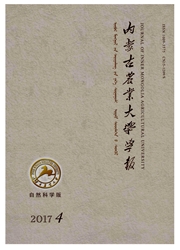

 中文摘要:
中文摘要:
通过对2005.10.1~2006.4.30非生长季寒温带兴安落叶松原始林气象要素分析发现,在非生长季期间,兴安落叶松林的气温最低可达-40℃以下,大气湿度却能够始终保持在50%以上,最高可达90%以上;土壤温度的变化随土壤深度的增加而减小,在1月底到2月初土壤温度达到最低值,但也只有-12℃左右;原始林林内积雪从11月份初开始不断增加,最高达18 cm,到次年4月末基本融化。分析表明:在寒温带兴安落叶松森林生态系统中,低温、高湿、稳定的土壤温度和深厚的积雪可能是非生长季兴安落叶松获得生理需要所必需的水分和其它营养元素,以维持非生长季微弱得水分代谢的基本途径之一,是兴安落叶松在极端恶劣的气候环境下能够良好生长的基本环境保证。这一分析,可以为研究兴安落叶松林生态系统的存在和发展提供基本的科学假设。
 英文摘要:
英文摘要:
Through the analysis of forestry meteorological factors of the dahurian larch ( Larix gmelinii) forest in non, ZHOU MeiI ,cropping season (from October 1, 2005 to April 30, 2006) in Cold, ZHOU MeiI ,temperate Zone, it was found that, in the non, ZHOU MeiI ,cropping season of daburian larch ( Larix gmelinii) : the lowest air temperature can reach below -40'(], but the forestry air moisture can maintain above 50% , and its highest can be above 90% ; the change scope of soil temperature will be smaller with the soil deeper, and in late January and early February the soil temperature will reach the lowest, about - 12~C ; from the early November, the snow quantity keep increasing, the maximum depth can reach 18cm, it will be thawed until next April. These observa- tions indicate that, in the forest ecosystem of dahurian larch (Larix gmelinii) in Cold - temperate Zone, low temperature, high moisture, stable soil temperature and deep snow maybe the guarantee of daburian larch ( Larix gmelinii) obtaining water and other nutrients physiologically needed, it was one of the essential ways to maintain weak water metabolism in non - cropping season, which ensures daburian larch (Larix gmelinii) get through the extreme climatic conditions. This study can provide basic scientific hypothesis for the research of existence and development of daburian larch ( Larix gmelinii) forest ecosystem.
 同期刊论文项目
同期刊论文项目
 同项目期刊论文
同项目期刊论文
 Foliar and soil N-15 natural abundances provide field evidence on nitrogen dynamics in temperate and
Foliar and soil N-15 natural abundances provide field evidence on nitrogen dynamics in temperate and CO2 Flux Estimation by Different Regression Methods from an Alpine Meadow on the Qinghai-Tibetan Pla
CO2 Flux Estimation by Different Regression Methods from an Alpine Meadow on the Qinghai-Tibetan Pla Rice to vegetables: short versus long-term impact of land use change on the indigenous soil microbia
Rice to vegetables: short versus long-term impact of land use change on the indigenous soil microbia C-13 abundance, water-soluble and microbial biomass carbon as potential indicators of soil organic c
C-13 abundance, water-soluble and microbial biomass carbon as potential indicators of soil organic c Spatiotemporal dynamics of aboveground primary productivity along a precipitation gradient in Chines
Spatiotemporal dynamics of aboveground primary productivity along a precipitation gradient in Chines Mechanism and bio-environmental controls of ecosystem respiration in a cropland in the North China P
Mechanism and bio-environmental controls of ecosystem respiration in a cropland in the North China P Litter production, leaf litter decomposition and nutrient return in Cunninghamia lanceolata plantati
Litter production, leaf litter decomposition and nutrient return in Cunninghamia lanceolata plantati Responses to N and P fertilization in a young Eucalyptus dunnii plantation: Microbial properties, en
Responses to N and P fertilization in a young Eucalyptus dunnii plantation: Microbial properties, en Effects of vegetation control on ecosystem water use efficiency within and among four grassland ecos
Effects of vegetation control on ecosystem water use efficiency within and among four grassland ecos 期刊信息
期刊信息
